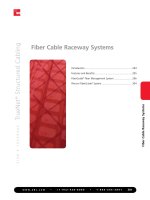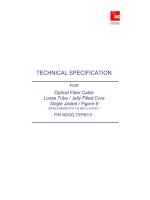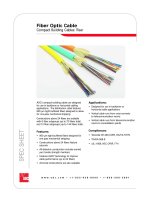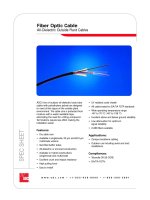Tài liệu ADC KRONE - White Paper - Data Center - 3 principles of Data Center Infrastructure Design (with n pptx
Bạn đang xem bản rút gọn của tài liệu. Xem và tải ngay bản đầy đủ của tài liệu tại đây (4.64 MB, 8 trang )
WHITE PAPER
The Three Principles
of Data Center
Infrastructure Design
The Three Principles of
Data Center Infrastructure Design
Understand These Three Principles
and You’ll:
• Lower your total cost of ownership
• Support your future growth plans
• Reduce your risk of downtime
• Maximize performance
• Improve your ability to reconfigure
Your data center is the most critical resource within your organization. As you
know, it provides the means for all storage, management and dissemination of
data, applications and communications for your business. When employees and
customers are unable to access the servers, storage systems and networking
devices that reside in the data center, your entire organization can shut
down. Millions of dollars can be lost in a matter of minutes for businesses
like banks, airlines, shipping facilities and online brokerages. Faced with these
consequences, IT executives today must optimize their data centers, particularly
the network infrastructure. When you consider that 70 percent of network
downtime can be attributed to physical layer problems, specifically cabling faults,
it’s paramount that more consideration be given to infrastructure design.
Within this white paper we introduce three principles, that when executed
properly, will help you gain significant benefits and savings throughout the life
of your data center.
Page 3
The Three Principles of Data
Center Design
When you understand the three principles of data center
design, you are able to:
• Lower your total cost of ownership
• Support your future growth plans
• Reduce your risk of downtime
• Maximize performance
• Improve your ability to reconfigure
Principle 1: Space Savings
Environmentally controlled real estate is expensive. The
cost of building a data center is more than $1,000 per
square foot in some cases (see Table 1). Data center
racks and equipment can take up an enormous amount
of real estate, and the future demand for more network
connections, bandwidth and storage may require even
more space. With insufficient floor space as the topmost
concern among IT managers today, maximizing space
resources is the most critical aspect of data center design.
Reliability Tier Tier I Tier II Tier III Tier IV
Construction
Cost/Square Ft
$450 $600 $900 $1,100
Annual Downtime
(Hours)
28.8 22 1.6 0.4
Site Availability
99.671% 99.749% 99.982% 99.995%
Source: Uptime Institute
Table 1. Construction Cost per Square Foot
Business environments are constantly evolving, and as
a result, data center requirements continuously change.
Providing plenty of empty floor space when designing
your data center enables the flexibility of reallocating
space to a particular function, and adding new racks and
equipment as needed.
As connections, bandwidth and storage requirements
grow, so does the amount of data center cabling
connecting key functional areas and equipment. Ample
overhead and underfloor cable pathways, as well as
abundant trough space, are also necessary for future
growth and manageability.
Reducing existing data center space is likely the most
expensive and disruptive problem your organization
can face. Expanding the physical space of a data center
can cost more than the original data center build
itself, requiring construction, movement of people and
equipment, recabling, and downtime. Given these
consequences, properly designing the data center for
space savings at the start is essential.
Cabling and connectivity components of the data center
infrastructure can have a direct impact on the amount
of real estate required in your data center. High-density
solutions require less rack, floor, and pathway space,
which leave more room for flexible reconfiguration
and growth.
Figure 1. Data Center with Flexible White Space
Principle 2: Reliability
Uninterrupted service and continuous access are critical
to the daily operation and productivity of your business.
With downtime translating directly to loss of income,
data centers must be designed for redundant, fail-safe
reliability and availability. Depending on the business,
downtime can cost anywhere from $50K to over $6
million per hour (see Figure 2).
Figure 2. Financial Impact of Network Downtime per Business
Data center reliability is also defined by the performance
of the infrastructure. As information is sent back and
forth within your facility and with the outside world,
huge streams of data are transferred to and from
equipment areas at extremely high data rates. The
infrastructure must consistently support the flow of data
without errors that cause retransmission and delays.
Cabling and connectivity backed by a reputable vendor
with guaranteed error-free performance help avoid
poor transmission within the data center. A substandard
performing data canter can be just as costly and
disruptive to your business as downtime.
The Three Principles of Data Center Infrastructure Design
0 2 4 6 8
$M Per Hour
ATM Fees
Airline Reservations
Online Sales
Credit Authorization
Brokerage Operations
Financial Impact of Network Downtime
Source: Strategic Solutions
The Three Principles of Data Center Infrastructure Design
Page 4
As networks expand and bandwidth demands increase,
the data center infrastructure must be able to maintain
constant reliability and performance. The cabling
itself should support current bandwidth needs while
enabling anticipated migration to higher network speeds
without sacrificing performance. In fact, the data center
infrastructure should be designed and implemented to
outlast the applications and equipment it supports by at
least 10 to 15 years. (Note that most active equipment is
replaced every three to five years.)
The protection of cabling and connections is a key factor
in ensuring data center reliability. Components that
maintain proper bend radius throughout cable routing
paths are critical to that protection. When cabling is
bent beyond its specified minimum bend radius, it can
cause transmission failures, and as more cables are
added to a routing path, the possibility of bend radius
violation increases (see Figure 3). Pathways must maintain
proper bend radius at all points where the cable makes
a bend — both at initial installation and when cables
are accessed or added. The separation of cable types
in horizontal pathways and physical protection of both
cable and connections should also be implemented to
prevent possible damage.
Principle 3: Manageability
Manageability is key to optimizing your data center. The
infrastructure should be designed as a highly reliable
and flexible utility to accommodate disaster recovery,
upgrades and modifications. Manageability starts with
strategic, unified cable management that keeps cabling
and connections properly stored and organized, easy to
locate and access, and simple to reconfigure.
Cable routing paths must be clearly defined and intuitive
to follow while enabling easy deployment, separation,
access, reduced congestion, and room for growth. This
is especially important in data centers with large volumes
of cables. Cables managed in this way improve network
reliability by reducing the possibility of cable damage,
bend radius violations, and the time required
for identifying, routing, and rerouting cables.
The use of a central patching location in a cross-
connect scenario provides a logical and easy-to-manage
infrastructure whereby all network elements have
permanent equipment cable connections that once
terminated, are never handled again. In this scenario,
all modifications, rerouting, upgrades, and maintenance
activities are accomplished using semi-permanent patch
cord connections on the front of the cross-connect
systems (see Figure 4).
Figure 4. Interconnection vs. Cross-Connection
The advantage to deploying centralized patching in your
data center include:
• Lower operating costs by greatly reducing the time it
takes for modifications, upgrades and maintenance.
• Enhanced reliability by making changes on the
patching field rather than moving sensitive
equipment connections.
• Reduced risk of down time with the ability to isolate
network segments for troubleshooting and quickly
reroute circuits in a disaster recovery situation.
Deploying common rack frames with ample vertical
and horizontal cable management simplifies rack
assembly, organizes cable, facilitates cable routing and
keeps equipment cool by removing obstacles to air
movement. Cable management at the rack also protects
the bend radius and manages cable slack efficiently.
Connectors must also be easily defined and accessed for
maintenance or reconfiguration with minimal disruption
to adjacent connections.
Maintaining proper radius
Fiber Patch Cord
Initial Installation
Violating minimum bend radius
Fiber Patch Cord
After Future
Installation
Figure 3. Care must be taken to avoid minimum
bend radius rules when adding fibers
The Three Principles of Data Center Infrastructure Design
Page 5
Choosing the Right Mix
of Equipment
Since the total spend for network infrastructure
equipment is but a fraction of the entire data center
cost, decisions for the so-called physical layer are often
taken lightly. But the fact remains that 70% of all
network downtime is attributed to the physical layer,
specifically cabling faults.
When selecting fiber and copper cable, connectivity
and cable management solutions for the data center,
it’s important to choose products and services that
satisfy the three principles outlined here. A data center
infrastructure without components that ensure space
savings, reliability and manageability discounts the goal
of optimizing the data center.
ADC's copper and fiber cable, connectivity, and cable
management solutions come together to provide a
comprehensive data center infrastructure solution that
lowers total cost of ownership, enables future growth,
and reduces risk of downtime.
• High-density copper and fiber solutions that take
up less rack, floor, and pathway space.
• Guaranteed performance for reliable transmission
and availability.
• Advanced cabling solutions ideal for today and for
migrating to 10 Gigabit Ethernet tomorrow.
• Cable management solutions that protect cable
and connections while offering easy identification,
accessibility, and reconfiguration.
Copper Cabling
For years, copper UTP solutions have been the preferred
network medium for horizontal cabling due to its cost-
effective electronics, familiar plug-and-play connections,
and easy installation. Data center horizontal cabling
is no exception. As businesses evolve and data center
needs grow, transmission speeds have migrated to
accommodate huge streams of data being transferred
back and forth between network equipment and servers.
ADC's TrueNet
®
CopperTen
™
Augmented Category 6
cabling provides a copper system with the necessary
characteristics to enable 10 Gbps Ethernet transmission
over a full 100 meters. Additionally, CopperTen is
backwards compatible to allow seamless migration from
existing Gigabit Ethernet devices to 10 Gbps Ethernet
in the future. For larger data centers where distances
reach beyond 55 meters and transmission speeds are
anticipated to reach beyond Gigabit Ethernet, CopperTen
provides peace of mind that the cabling will support
equipment and applications for many years. With
CopperTen in the data center, you won't have to worry
about recabling down the road.
High-performing Category 6 cabling solutions also have
their place in the data center with the ability to support
advanced applications, including 10 Gigabit Ethernet to
a limited distance of 55 meters. ADC's TrueNet
®
Category
6 cable offers best-in-class performance with extra
bandwidth and guaranteed zero bit errors. In the data
center, the smaller diameter of TrueNet Category 6
cable saves as much as 32% of available cable pathway
space. TrueNet Category 6 cable offers valuable data
center space savings, reliable performance, and easier
cable management.
Fiber Optic Cabling
With the same percentage of terminations as copper,
fiber optic cabling and connectivity is a significant part
of the data center. Fiber links are also the most critical
links because they carry data to and from a large number
of sources, including outlying telecommunication rooms
and the outside world. Some data center designers
tend to underestimate fiber optic cabling requirements,
believing that a few strands will suffice for current and
future needs. But emerging technologies continue to
be layered onto the network, and because fiber optic
cabling is backward, and not forward compatible,
designers should choose the fiber type capable of
supporting all the current and future applications
in the data center.
Laser optimized 50µm multimode fiber was created as
the industry moved to 10 Gbps Ethernet. Traditional LED
signaling technology could not support the higher speeds
and a shift was made to cost-effective short-wavelength
(850nm) Vertical Cavity Surface Emitting Lasers (VCSELs).
However, standard multimode fiber is not optimized for
VCSELs, and as a result cannot support the necessary
distances. By removing the impurities and carefully
grading the index of refraction of the core of multimode
fibers, laser optimized 50µm multimode fiber can achieve
10 Gbps Ethernet to 550 meters (see Figure 5).
Figure 5. Standard Multimode Fiber vs.
Laser Optimized Multimode Fiber
Cladding
Core
10 Gbps
850 nm Laser
Detector
Cladding
Core
10 Gbps
850 nm Laser
Detector
Laser Optimized MM fibers control DMD to support 10 Gb/s up
to 300 or 550 meters with low cost 850 nm serial applications.
10 Gb/s reliable transmission, design flexibility









